Chinese Nationalist Party (KMT) chairperson candidates yesterday focused on the so-called “1992 consensus” during a televised policy debate ahead of next week’s election.
KMT Chairman Johnny Chiang (江啟臣) said the party should return to the “original definition of the consensus,” adding that the concept was no longer a poison pill for voters, as the Democratic Progressive Party (DPP) had demonstrated its inability to handle cross-strait relations.
The “1992 consensus” — a term that former Mainland Affairs Council chairman Su Chi (蘇起) in 2006 admitted making up in 2000 — refers to a tacit understanding between the KMT and the Chinese Communist Party (CCP) that both sides of the Taiwan Strait acknowledge that there is “one China,” with each side having its own interpretation of what “China” means.

Photo courtesy of CTV
Former KMT chairman Eric Chu (朱立倫) said that he has also emphasized that each side has its own interpretation of the “1992 consensus” and had reiterated this to Chinese President Xi Jinping (習近平) when they met in 2015.
“In essence, there must be a creative ambiguity, instead of clear-cut clarity,” Chu said.
Sun Yat-sen School president Chang Ya-chung (張亞中) said that while the “1992 consensus” should remain the party’s guiding principle, it is outmoded and can no longer address the political situation of cross-strait relations.
If elected, he said he would visit Beijing to find common ground that both sides can accept and to sign a memorandum of understanding for peace, adding that this would require that both sides take a step back.
Former Changhua County commissioner Cho Po-yuan (卓伯源) said that the DPP’s abandonment of the “1992 consensus” has led to heightened tensions across the strait, adding that he believed attempts to deepen the “consensus” would be the way toward peace.
On whether the party should change its name, Chu said he was “absolutely against” changing it to “Taiwan Kuomintang.”
Such an act would sever the party from its past, he said, adding that the KMT should push against efforts to create pro-Taiwan independence high-school curricula, which would mislead young people about the nation’s roots.
Chang said the KMT was founded by Sun Yat-sen (孫逸仙) and had a century’s history and glory to its name, adding that the word Chinese (中國) in the party’s official name also held meaning.
“It is a place that our revolutionary forefathers spilled blood for,” Chang said, adding that the word does not simply mean the People’s Republic of China, as “it also means us. We are Chinese. Taiwanese are Chinese, as they are also Taiwanese.”
During the debate, Chu said that if Chang were elected, he would steer the KMT toward rapid unification, while Chang said that he was “extremely unhappy” that Chu was attempting to divide the party.
Instead of lobbing accusations that the KMT is leaning toward China and selling out the country or that the DPP is simply a stooge for the US, Chiang said that the country needs to sit down with the CCP to discuss matters, adding that he is willing to visit China should he be re-elected.
He said that the KMT must bring the fight to the DPP, as Taiwanese have for a long time been subject to a single source of information.
The KMT chairperson election is set for Saturday next week.

SHIPS, TRAINS AND AUTOMOBILES: The ministry has announced changes to varied transportation industries taking effect soon, with a number of effects for passengers Beginning next month, the post office is canceling signature upon delivery and written inquiry services for international registered small packets in accordance with the new policy of the Universal Postal Union, the Ministry of Transportation and Communications said yesterday. The new policy does not apply to packets that are to be delivered to China, the ministry said. Senders of international registered small packets would receive a NT$10 rebate on postage if the packets are sent from Jan. 1 to March 31, it added. The ministry said that three other policies are also scheduled to take effect next month. International cruise ship operators

HORROR STORIES: One victim recounted not realizing they had been stabbed and seeing people bleeding, while another recalled breaking down in tears after fleeing A man on Friday died after he tried to fight the knife-wielding suspect who went on a stabbing spree near two of Taipei’s busiest metro stations, Taipei Mayor Chiang Wan-an (蔣萬安) said. The 57-year-old man, identified by his family name, Yu (余), encountered the suspect at Exit M7 of Taipei Main Station and immediately tried to stop him, but was fatally wounded and later died, Chiang said, calling the incident “heartbreaking.” Yu’s family would receive at least NT$5 million (US$158,584) in compensation through the Taipei Rapid Transit Corp’s (TRTC) insurance coverage, he said after convening an emergency security response meeting yesterday morning. National

PLANNED: The suspect visited the crime scene before the killings, seeking information on how to access the roof, and had extensively researched a 2014 stabbing incident The suspect in a stabbing attack that killed three people and injured 11 in Taipei on Friday had planned the assault and set fires at other locations earlier in the day, law enforcement officials said yesterday. National Police Agency (NPA) Director-General Chang Jung-hsin (張榮興) said the suspect, a 27-year-old man named Chang Wen (張文), began the attacks at 3:40pm, first setting off smoke bombs on a road, damaging cars and motorbikes. Earlier, Chang Wen set fire to a rental room where he was staying on Gongyuan Road in Zhongzheng District (中正), Chang Jung-hsin said. The suspect later threw smoke grenades near two exits

The Forestry and Nature Conservation Agency yesterday launched a gift box to market honey “certified by a Formosan black bear” in appreciation of a beekeeper’s amicable interaction with a honey-thieving bear. Beekeeper Chih Ming-chen (池明鎮) in January inspected his bee farm in Hualien County’s Jhuosi Township (卓溪) and found that more than 20 beehives had been destroyed and many hives were eaten, with bear droppings and paw prints near the destroyed hives, the agency said. Chih returned to the farm to move the remaining beehives away that evening when he encountered a Formosan black bear only 20m away, the agency said. The bear